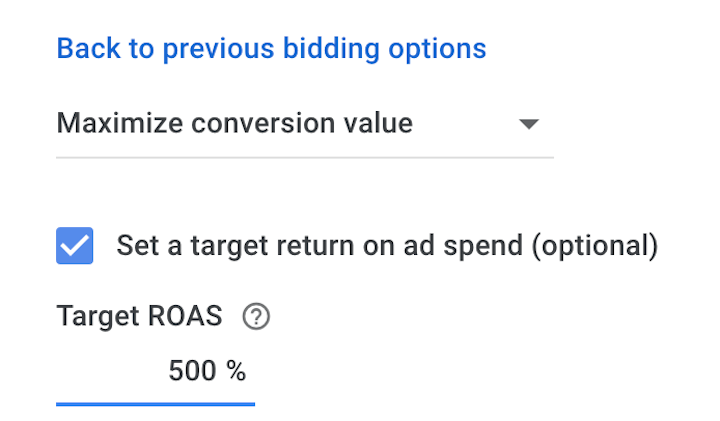Are you struggling to achieve your desired return on ad spend (ROAS) for your Google Ads campaigns? Look no further! We’re here to help you navigate the world of Target ROAS bidding, an essential tool for advertisers looking to maximize their conversion value. In this comprehensive guide, we’ll break down what Target ROAS is, how it works, and how to set it up effectively. So grab a coffee, sit back, and let’s dive in.

Understanding Target ROAS
Target ROAS, or return on ad spend, is a Google Ads Smart Bidding strategy that uses machine learning to predict the value of potential conversions for each user search. It then automatically adjusts your bids to maximize your return on investment. With Target ROAS, you can optimize your bids for higher-value conversions, ensuring that your ad spend brings in the most revenue possible.
When to Use Target ROAS Bidding
Value-based bidding is ideal for businesses that have varying conversion values or specific ROAS targets they want to achieve. Target ROAS is perfect for you if:
- Your business has a specific ROI target.
- The conversions you optimize for have different values.
- You want to maximize your conversion value within a specific ROAS target.
- Target ROAS Requirements
Before you can apply Target ROAS to your campaigns, you need to meet certain requirements:
Set values for your tracked conversions.
Have a minimum number of conversions in the past 30 days, depending on the campaign type:
- Display campaigns: 15 conversions
- App campaigns: 10 conversions per day (or 300 in 30 days)
- Discovery campaigns: 75 conversions (10 of which must be within the last 7 days)
- Video Action campaigns: 30 conversions
- Setting Up Target ROAS Bidding
Now that you know what Target ROAS bidding is and when to use it, let’s discuss how to set it up in your Google Ads account. Here’s a step-by-step guide:
- Create a new bid strategy: You can create a Target ROAS bid strategy for a single campaign (standard strategy) or multiple campaigns (portfolio bid strategy).
- Determine your target ROAS: Your target ROAS is the average conversion value you’d like to achieve for each dollar you spend on ads. Use historical data, recommendations from Google Ads, or your desired ROI to set a target that’s right for your business.
- Consider bid adjustments: Although Target ROAS optimizes bids based on real-time data, you can still set device bid adjustments of -100%. All other bid adjustments won’t be used, so there’s no need to remove them.
- Apply ad group targets (optional): With a portfolio strategy, your campaigns, ad groups, and keywords are optimized collectively for a single target. You can set individual targets for each ad group, but this isn’t recommended as it can restrict Smart Bidding.
- Monitor your average target ROAS: This metric lets you measure the ROAS that your bid strategy targeted for specific time periods. By changing the date range, you can learn what your strategy optimized for over that period.
Table 1: Comparing Bidding Strategies
| Strategy | Goal | When to Use |
|---|---|---|
| Max Conversions | Maximize conversions for budget | Priority is to spend the budget. No specific ROI target. Conversions have similar values. |
| Target CPA | Maximize conversions within tCPA | Specific ROI target. Conversions have similar values. |
| Max Conversion Value | Maximize conversion values for budget | Priority is to spend the budget. Conversions have different values. No specific ROI target. |
| Target ROAS | Maximize conversion value within tROAS | Specific ROI target. Conversions have different values. |
Table 2: Target ROAS Requirements by Campaign Type
| Campaign Type | Conversions Required (Past 30 Days) | Additional Requirements |
|---|---|---|
| Display | 15 | Set values for tracked conversions |
| App | 300 (10/day) | Set values for tracked conversions |
| Discovery | 75 (10 within last 7 days) | Set values for tracked conversions |
| Video Action | 30 | Set values for tracked conversions |
Now that you have a good understanding of Target ROAS bidding and its requirements, let’s explore some best practices to optimize your strategy.
Best Practices for Target ROAS Bidding
- Use realistic targets: Set achievable target ROAS based on historical data or recommendations from Google Ads. If you set overly ambitious targets, you may limit the volume of conversions and impact the overall performance of your campaigns.
- Start with broader targeting: It’s recommended to start with broader targeting when using Target ROAS bidding. As the algorithm learns, it will optimize for better performance, and you can gradually narrow your targeting.
- Give it time: Smart Bidding strategies like Target ROAS require time to learn and adapt. Expect fluctuations in performance during the initial learning phase, which typically lasts 7-14 days.
- Evaluate performance over longer periods: Assess your campaign’s performance over longer periods (e.g., 30 days) rather than shorter ones (e.g., 7 days). This will provide a more accurate representation of your strategy’s effectiveness.
- Leverage Google Ads Recommendations: Regularly review your Google Ads Recommendations to identify optimization opportunities that can help improve your Target ROAS strategy.
Final Words
Target ROAS bidding is an indispensable tool for businesses looking to optimize their ad spend and maximize conversion value. By understanding its requirements, setting it up correctly, and following best practices, you can unlock the full potential of this powerful Smart Bidding strategy. It’s time to take control of your ad spend and drive better results for your business. Happy bidding!
Moiz Banoori is a Digital Marketing specialist with over eight years of experience in content creation and digital journalism. He leads teams at various brands and focuses on developing effective SEO strategies that enhance online visibility. With a degree in journalism, Moiz combines his passion for storytelling with technical skills to deliver innovative digital solutions at REDLUMB, helping clients achieve their online goals in a competitive landscape.



![What is PPC in Digital Marketing? [Comprehensive Overview]](https://redlumb.ae/wp-content/uploads/2024/11/REDLUMB-Template-12-680x456.jpg)
